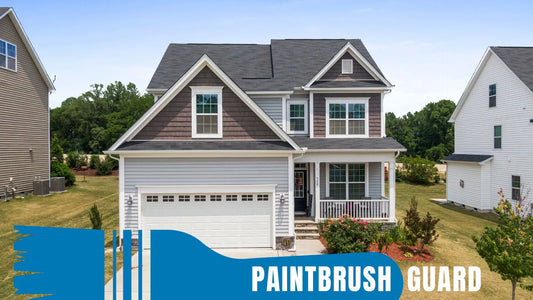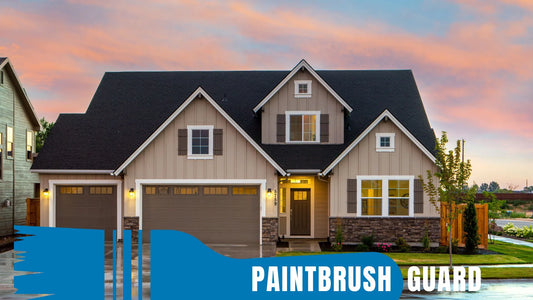Exterior trim painting transforms your home’s curb appeal and protects surfaces like window frames, door casings, and fascia from weather damage.
Proper preparation is critical for a durable, professional-quality exterior trim painting result, preventing issues like peeling or uneven finishes.
This in-depth guide covers every aspect of preparing for exterior trim painting, ensuring your project succeeds.
Whether you’re a DIY homeowner or hiring professionals, these steps will help you achieve a flawless exterior trim painting outcome.
This is one part of a complete exterior house painting guide.
Why Prep Is Key for Exterior Trim Painting
Preparation is the backbone of successful exterior trim painting. Trim, often wood, metal, or vinyl, faces harsh elements, making it prone to damage without proper prep.
Thorough preparation ensures paint adheres well, lasts longer, and looks polished, avoiding costly touch-ups.
By mastering these prep steps, you set the stage for a high-quality exterior trim painting project that boosts your home’s value and aesthetic.
Inspecting for Exterior Trim Painting Success
Before starting exterior trim painting, thoroughly inspect all trim surfaces to identify issues.
Check for peeling or flaking paint, signaling moisture or poor prior prep. Look for wood rot, cracks, or splits, especially on older homes.
For metal trim, inspect for rust or corrosion; for vinyl, check for warping or fading. If your home was built before 1978, test for lead paint, requiring special handling with protective gear and lead-safe practices.
A detailed inspection catches problems early, ensuring effective exterior trim painting.
Lead Paint Precautions
For older homes, lead paint demands caution. Use a certified testing kit to confirm its presence. If found, follow EPA guidelines, like wet sanding and HEPA vacuums, to minimize dust.
Hiring a lead-safe certified contractor may be necessary for safe exterior trim painting.
Cleaning for Flawless Exterior Trim Painting
Clean trim is vital for exterior trim painting to ensure paint sticks properly. Dirt, dust, or mildew can cause peeling or uneven finishes.
Use a pressure washer at a low setting (1,200-1,500 PSI) to remove grime without damaging trim. For delicate areas, hand wash with mild detergent and a sponge. In humid or shaded spots, treat mildew with a bleach-based remover to kill spores.
Allow 24-48 hours for drying, depending on weather. Thorough cleaning is non-negotiable for a smooth exterior trim painting result.
Mildew Treatment Tips
Mildew thrives in damp areas. Apply a mix of one part bleach to three parts water, scrub gently, and rinse well. This prevents regrowth, ensuring a clean surface for exterior trim painting.
Removing Stubborn Grime
For tough dirt or grease, use a TSP (trisodium phosphate) solution, rinsing thoroughly to avoid residue. This extra step enhances paint adhesion during exterior trim painting.
Scraping and Sanding for Exterior Trim Painting
Removing loose paint and smoothing surfaces is crucial for exterior trim painting. Gently scrape peeling paint with a paint scraper, avoiding damage to wood or metal.
Sand rough areas with 120-150 grit sandpaper for a uniform surface. Hand sanding offers precision on intricate trim, while a power sander speeds up larger areas.
Wipe with a damp or tack cloth to remove dust, as particles can ruin the finish. Proper scraping and sanding ensure a seamless exterior trim painting outcome.
Repairing Damage Before Exterior Trim Painting
Fixing damaged trim is essential for exterior trim painting to achieve a polished look and prevent further issues.
For wood trim, fill cracks or holes with exterior-grade caulk or wood filler, smoothing with a putty knife. Replace severely rotted sections for structural integrity.
For metal trim, sand rust and apply a rust converter. Ensure repairs cure fully—typically 24 hours for fillers—before proceeding. These repairs create a stable base, boosting exterior trim painting durability.
Priming for Durable Exterior Trim Painting
Priming seals surfaces and ensures paint adhesion, a must for exterior trim painting. Select a primer suited to your trim: latex for wood or vinyl, oil-based for metal or stained surfaces, or specialty primers for galvanized metal.
Apply with a 2-inch angled brush for precision, covering evenly. Let it dry fully (4-8 hours) for a uniform base. Priming prevents peeling and enhances exterior trim painting appearance.
Protecting Areas in Exterior Trim Painting
Protecting windows, siding, and landscaping simplifies cleanup during exterior trim painting. Use painter’s tape to mask adjacent areas, ensuring a tight seal to prevent bleed.
Cover plants, walkways, or patios with canvas drop cloths, more durable than plastic. Trim vegetation for better access and to avoid paint on leaves. Proper protection keeps exterior trim painting clean and efficient.
Weather Planning for Exterior Trim Painting
Weather impacts exterior trim painting quality. Paint applied in extreme heat, cold, or humidity may bubble or peel. Aim for 50°F to 85°F with low humidity, ideally in spring or fall.
Avoid rain or high winds, which disrupt drying or carry debris. Allow extra drying time in humid conditions. Smart timing ensures top-notch exterior trim painting results.
Safe Access for Exterior Trim Painting
Trim on upper stories or intricate areas requires safe access for exterior trim painting. Use a sturdy ladder for single-story homes, or scaffolding and extension poles for multi-story ones.
Ensure ladders are stable on level ground and wear safety gear like gloves, goggles, and a mask, especially for lead paint or sanding. For high trim, consider professionals for safety. Safe access improves exterior trim painting quality.
Conclusion
Exterior trim painting elevates your home’s look and protects surfaces when prepped right. By inspecting, cleaning, scraping, sanding, repairing, priming, protecting, and planning for weather and access, you ensure a professional exterior trim painting finish.
These steps, tailored to wood, metal, or vinyl trim, set you up for success. Start your exterior trim painting project today for a stunning, lasting result.
This is one part of a complete exterior house painting guide.
















